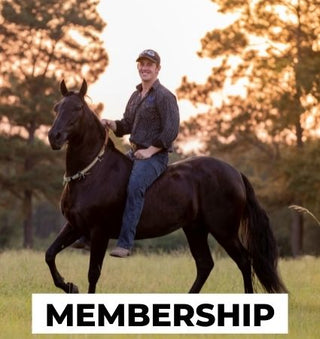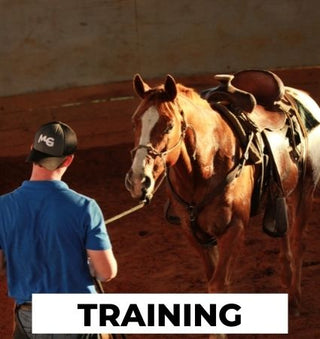In this blog, we'll discuss the techniques and benefits of advanced flexing in motion, providing you with the tools to transform your horse's responsiveness and behavior.
Watch the Video Here or continue reading below!
What’s going on Team MG! I’m back with another video a lot of people have been asking about, the advanced flexing in motion. Here’s what I’m looking for.
We know horsemanship flexing is just one hand, and so much of the Horse Help Course and what we teach is just one-handed flexing. Get that horse flexing, the motion being one hand at a time. Just look left, look right, so on, and so forth. But, as you start getting that horse more advanced, we go from one-handed flexing to finish flexing, or advanced flexing. That’s going to look like this, where we use two hands, and we’re looking see how that horse drops his head. That’s called breaking from the poll. The polls the top piece of the horse’s head between their ears. We’re looking for him to give there and we do that by not giving up the outside rein. See, as I flex right and then keep pressure on the left rein, so it makes him look downward.
Get The Horse Soft In the Face
A horse like this, that’s a buck threat and that likes to crow hop, that likes to buck. The softer and more broke in the face we get him, the less likely he is to do any shenanigans. Then, putting that in motion, one of the tricks that I like to use a lot is, I will hold my rein below my knee here on my left leg as I’m traveling forward. Then I will flex to my hip on the right side and release. A lot of times I’ll put the reins, instead of in front of my saddle, I’ll put them behind my saddle horn down by my legs.
Flex With Downward Pressure
As long as he has his head down, he’s comfortable and he feels like he’s on a loose rein. Having that slack past your knee, it really gives you a low vantage point. A really low place that you’re pulling from. Remember, halters and snaffles are direct contact, so wherever your hand is, is where the horse’s head goes. If your hands come up here higher, you’re asking for that horse’s head to come up. Our ability to be able to flex him and have all the pressure be downward is key.
That’s why when you’re using long lines, they really like to put their head down. This is because the long lines are coming through the stirrups and the stirrups are even lower than what my hands are here. Then we’ll switch, and I’ll go to this other side, to the left, and it’s the same thing let me turn around where you can see.
Find The Release
Notice, that slack is down here below my knee. Whenever I start asking him to flex on this left side, that rein can’t give anymore because my leg is already touching him, and I can start asking him to give. We want him to feel like the only comfortable place is in between my two hands, that is where the release is. This horse, when he came to us for training, likes to have his head up here in the sky. Whenever he starts bucking, when he starts Crow hopping, nobody could deal with him. He’s a big strong specimen, so when he would do that, I mean you were either going to hold on for dear life or get ejecto seated.
The Pressure Is Not The Issue
Now, he is softening in the face. Look, I’m even happy to be wearing spurs on him. I mean if you would hear the stories about this horse before he came here you would think he’ll never ride in Spurs, he’ll kill you. The pressure is never the issue. His inability to listen to it, and his ideas that we can’t touch him with spurs, or a crop, or kiss to him because he’ll buck.
Now that he’s softening up in that halter, I can ride him around. We’ll see if we get that canter departure without a buck. See how he wants to pick his head up, that’s exactly what I’m talking about, as you go faster, they want to get stiffer.
Flexing Is Priority Over Speed
Right now, flexing in motion is my priority over going fast. Notice as I went fast, he wanted to pick his head up and get straight. I’m going to ask him again. Notice even at this canter, I’m still looking to keep him off center, I’m still looking to flex him in motion.
I even kept him flexed during the stop. Guys, that is basically in a nutshell what will get you advanced flexing in motion. So soft, and so easy, at any speed forward. Your ability to get him to flex in motion, however fast you’re willing to go, the horse should flex at that speed. Michael ,that doesn’t make sense, huh nobody’s flexing, yes, yes, they are! If you see the reiners in the show arena, they do everything straight and square. When they’re in the warm-up pen those horses can canter and look at their rider, because they’re so disconnected. From their face to their body, they are flexed. That rider’s in such great control, that the horse doesn’t think that they can do anything with the rider.
Your ability to disconnect him from here, was our ability to take this horse from an, I’ll Buck anybody off horse, to a, I might get this horse and start doing some roping on him type horse. As long as he stays here, because man, he has the perfect build to be a good head horse.
In Conclusion Of Advanced Flexing In Motion
That’s advanced flexing. The difference between flexing in motion and advanced flexing in motion is simply that we’re using two hands instead of one. Instead of just turning his head to the right, he is dropping his head and turning his head to the right. He is breaking from the poll and looking to put his nose down and in. The end goal of any finished horse is at the walk, trot, or canter, if we pulled in a straight line, that we could put his head down to vertical. That’s a very fancy way of saying, put your nose down, put your head down. That we can just go straight here, where he is flexed and soft at the poll. Before you get to that point, where you just pick up the reins and he wants to drop his head, we have to get him off center.
Whenever, we take his face away from center, it takes away his power. We do that by flexing in motion. It’s a lot easier to work on going to the side, than going in a straight line. Try this at home, and I’m telling you, you’re going to see huge differences in your horses. Thanks so much for watching, I’ll see you in the next video!
Check out more free training resources HERE!










